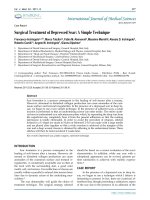Báo cáo y học: "In-flight medical emergencies: time for a registry"
Bạn đang xem bản rút gọn của tài liệu. Xem và tải ngay bản đầy đủ của tài liệu tại đây (38.98 KB, 2 trang )
Available online />Page 1 of 2
(page number not for citation purposes)
Abstract
When a passenger becomes sick while flying on board a
commercial airline flight, the cabin crew commonly solicit the
assistance of a volunteer physician. Although in-flight medical
emergencies take place every day, little is known about the
epidemiology of these events. A new study by Sand and
colleagues sheds light on the incidence of specific illnesses that
occurred on board commercial flights.
Airline travel is safe and reasonably comfortable, but many
factors, including psychological stress, jet lag, and pre-
existing disease, can cause a small number of passengers to
become ill. There is no central registry of in-flight medical
emergencies. Each airline tracks its own events, making it
difficult to determine the true incidence of specific illnesses
that occur during flight. In a recent article published in Critical
Care, Sand and colleagues [1] studied the epidemiology of
in-flight medical emergencies by collecting data from two
European airlines over 5 years. This study provides valuable
information that is of interest to specialists in aerospace
medicine and to every physician who travels by air and may
be called upon to help a fellow passenger. Epidemiologic
studies such as this one make it possible to conduct
meaningful research and can be used to identify trends in in-
flight medical emergencies. The ultimate benefit is improved
clinical management of passengers who become patients.
Understanding which illnesses are most likely to occur will
improve the care of passengers who need emergency
medical assistance while traveling on board commercial
flights. Most airlines rely upon the presence of a volunteer
with medical training to treat a sick passenger until the
airplane lands and the passenger can be taken to an
emergency room [2]. Ideally, physicians can learn about the
physiological changes that occur during flight and tailor their
care accordingly. The Yale Aerospace Medicine Group has
previously recommended, for example, that patients or
physicians using pulse oximeters on board commercial
aircraft should understand that all passengers are mildly
hypoxic and should have a plan of care that takes this fact
into account [3]. Knowing in advance which patients are most
likely to become ill will help the aerospace medicine
community to develop training materials for physicians who
might be asked to volunteer. Epidemiologic studies will also
be of assistance to physicians who evaluate patients for
fitness to fly for long distances.
The Air Transport Medicine Committee of the Aerospace
Medical Association (ASMA) has developed a series of
recommendations for the contents of an emergency medical
kit. ASMA periodically updates these recommendations, but
the latest recommendation specifically cites the lack of
industry-wide data as a problem and encourages the
collection of this important information [4]. Epidemiologic
studies can help ASMA and the airlines to tailor emergency
medical kits for the conditions that are most likely to occur.
Although US airlines are required to carry a comprehensive
medical kit on all flights, regulations outside the US vary, and
emergency medical equipment may be sparse, especially on
‘no-frills’ airlines [5]. The ability to predict the likelihood of a
specific illness, combined with a program that tracks which
components of the medical kit are used can help airlines and
regulatory authorities to create policies that serve the flying
public while eliminating unnecessary equipment.
The lack of a central registry makes it difficult to conduct
research as to the true incidence of many in-flight events.
Sand and colleagues have identified the lack of standardi-
zation in both reporting requirements and terminology to be a
major roadblock in their study. Although the authors do not
make this recommendation, they present a cogent argument
in favor of a centralized registry of in-flight medical emer-
gencies. The information gained from epidemiologic studies
of in-flight medical emergencies is of benefit to the airlines,
Commentary
In-flight medical emergencies: time for a registry?
Keith J Ruskin
Yale University School of Medicine, Cedar Street TMP3, New Haven, Connecticut 06520, USA
Corresponding author: Keith J Ruskin,
Published: 25 February 2009 Critical Care 2009, 13:121 (doi:10.1186/cc7715)
This article is online at />© 2009 BioMed Central Ltd
See related research by Sand et al., />ASMA = Aerospace Medical Association.
Critical Care Vol 13 No 1 Ruskin
Page 2 of 2
(page number not for citation purposes)
aerospace medical researchers, and the traveling public.
Sand and colleagues’ study should serve as a template for
future research in this important area.
Competing interests
The author declares that they have no competing interests.
References
1. Sand M, Bechara FG, Sand D, Mann B: Surgical and medical
emergencies on board European aircraft: a retrospective
study of 10189 cases. Crit Care 2009, 13:R3.
2. Ruskin KJ, Hernandez KA, Barash PG: Management of in-flight
medical emergencies. Anesthesiology 2008, 108:749-755.
3. Wagner JL, Ruskin KJ: Pulse oximetry: basic principles and
applications in aerospace medicine. Aviat Space Environ Med
2007, 78:973-978.
4. Thibeault C, Evans A; Air Transport Medicine Committee, Aero-
space Medical Association: Emergency medical kit for com-
mercial airlines: an update. Aviat Space Environ Med 2007, 78:
1170-1171.
5. European Joint Aviation Authorities: JAR-OPS1, Commercial Air
Transportation (Aeroplanes), Global Engineering Documents.
Englewood, USA.









